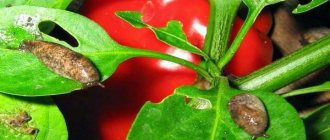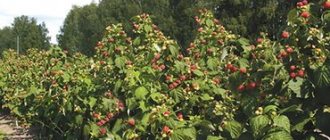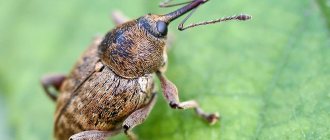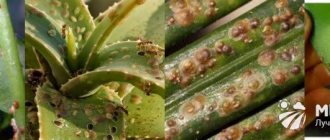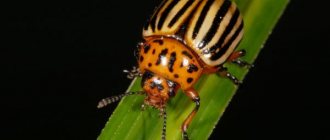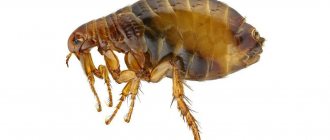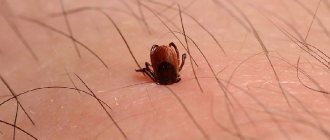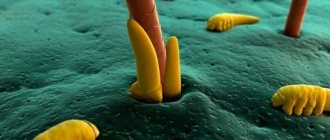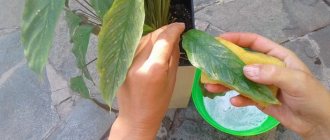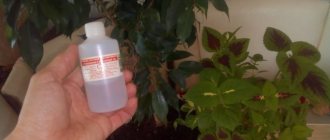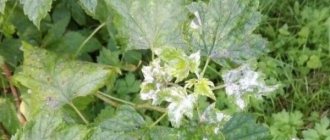Home / Flowers
Back
Published: 07/12/2019
1
Rate this post
The rose is deservedly called the queen of flowers for its beauty and wonderful aroma. Every queen must have servants, and this also applies to roses. It is you who must serve her. If you become negligent in caring for your rose bushes, they will not only not give you beautiful flowers, but they may even die.
The same thing can happen if you do not protect the bushes from the invasion of enemies, and the queen of flowers has more than enough of them. These are diseases, as well as harmful insects. How can you fight and win against them?
When treating roses against pests with chemicals, you only need to wear clothes made of thick fabric, rubber gloves, goggles, and be sure to use a respirator. Wrap your head in a scarf. After completing work, wash your face and hands with soap, or better yet, take a hot shower.
Pests on roses appear in early spring, when the buds just begin to swell. They torment the beauty until late autumn. That is why you need to take care of your flower garden throughout the growing season, taking care of them in late autumn, preparing the bushes for a comfortable winter. The same whitefly affects not only garden but also indoor flowers.
Rose pests drain the vitality of plants and make flowers vulnerable to disease. If you find small enemies that cause great damage to the garden, fight them immediately.
- 1 Tracks
- 2 Roseate sawflies
- 3 Rose aphid
- 4 Slobbery Penny
- 5 Leafhopper
- 6 Leafrollers
- 7 Spider mite
- 8 Beetles - bronze beetle and fawn
- 9 Leaf Cutter Bee
- 10 Weevil
- 11 Thrips
Spider mite
It is active in dry, hot summers, when the temperature remains stable within +29 - +31 °C. The number of pests increases instantly, since the colony is replenished with new individuals every 14 days. Spider mites suck the juices of the leaves. Spots and bumps appear on damaged plates. The leaves curl, darken, and fall off.
When a flower garden is significantly infested, small beetles eat the whole roses - leaves, stems, developing buds, flowers. A characteristic sign of the presence of a pest is the presence of cobwebs. The bugs themselves are miniature in size - up to 2 mm, white, yellow, green, red. If you notice cobwebs and white bugs on a rose, you need to act immediately.
Bee leafcutter
Parasitizes in late June, early June. Damages leaves. A clear sign of leaf cutter sabotage is the presence of regularly shaped holes on the plate. The flowers remain untouched. The insect uses the pieces as building material.
A bee builds a nest in the immediate vicinity. Construction requires about 1,000 circles of different diameters. The bee carefully folds them and later glues them together with a special substance. To cut out the desired shape, the insect sits on a rose leaf, clings with its jaws, and spins around itself. Takes the material and flies away.
On a note!
The insect does not cause any particular harm to roses, but it significantly spoils the presentation. The likelihood of developing fungal diseases increases slightly.
Bronzovka
A large beetle with an attractive appearance. The bronze body size reaches 15 mm. The dense shell shimmers in the sun with a copper sheen. Shows activity in June and July, especially loves white and yellow roses. The beetle feeds on leaves. The bronze beetle is also popularly called the Maybug or Khrushchev.
Rose pests
The larvae are large, white caterpillars with long legs and a brown head. They live in the soil and feed on the root system of plants. The larvae weaken the plant and reduce disease resistance. If several pests are parasitizing at once, the plant may die. The May beetle on roses is not a common occurrence, but it is dangerous for a flower garden.
Insects on roses - how they harm and why they eat leaves and buds
Delicate rose buds are sensitive to pests. If insect control is not organized in time, you can lose your plants. You need to know what and how to treat roses in order to prevent harm to them. Treat the bushes in a timely manner, protecting the rest of the vegetation in the garden plot.
Insect pests on roses
What to do if pests appear and the flower begins to die. How to deal with pests?
When insects appear that negatively affect roses, it is recommended to immediately resort to the use of pesticides. Folk remedies are suitable as prophylaxis if there is a mild infection with small localization. In other cases, you need to act immediately to prevent pests from spreading throughout the garden.
Important! Before treating plants with chemical solutions, it is recommended to take measures to protect yourself. Use personal protective equipment for respiratory organs, eyes and hands.
General diagram of the placement of pests on a rose bush
There are a huge number of insects that damage rose bushes. They affect foliage, stems, buds and even the root system of plants. It all depends on the pest and what it feeds on.
Aphid
The most common pest. Only a cold, rainy summer can save flowers. In hot weather, aphids reproduce rapidly, with about 20 generations replacing each season. Small green bugs on roses, no more than 2 mm in size, live on the underside of the leaf. When massively infected, crops stick to the stems and penetrate into the buds and blossoming flowers.
Green insects feed on sap. There is no significant harm from one individual, but aphids live in numerous colonies, so they can destroy a plant in a few weeks. The female lays eggs daily on the leaves of roses. After a couple of days, larvae appear and make passages in the leaves.
On a note!
Signs of roses being affected by aphids are curled, yellowed, blackened leaves, slower plant growth, and falling buds. When examining the flower, a colony of beetles is discovered. Emergency measures on the part of humans or a sharp cold snap can save roses.
Pests suck out the juices, reducing the resistance of roses to diseases. Infection and fungi penetrate into damaged platinum. This subsequently leads to the death of the culture.
Insect damage to rose bushes
During the period of active growth, roses are very vulnerable and require additional protection measures, because their newly formed buds and first leaves are a source of food for pests and their larvae.
Many gardeners cannot immediately determine who is eating rose leaves. The danger comes from both aphids and gnawing parasites: caterpillars, beetles, sawflies (especially their larvae). Due to the reduction in size and damage to surfaces, the plant slows down in growth, the volume and duration of flowering decreases. Gnawing pests are capable of the following:
- gnawing the pulp of leaves around the veins in the form of holes, while the veins remain intact;
- gnawing the edges of the sheet (usually curly);
- making passages through the leaf body (mining) and plant stems;
- eating buds and petals from the outer edge;
- eating stamens and pistils.
The most common sucking insects that harm rose bushes are mites, aphids, scale insects and cicadas (especially rose whiteflies). The above pests can appear in both protected and open ground.
Insect damage to rose bushes
Weevil
Black beetles on roses with long noses are weevils. Large pests with a massive body - up to 1 cm. The shell is hard, convex, there are no wings. The beetles only crawl, hiding during the day in a secluded place: under lumps of earth, leaves, on neighboring trees. They are active at night. They eat leaves of all types of roses and rose hips.
Rose pests
The larvae cause more damage to flowers. Large legless caterpillars are white. They live in the soil and feed on the roots of roses. Mass infection quickly leads to the death of the plant. The presence of parasites can be suspected by the weak growth of roses and sluggish flowering.
On a note!
Flowers growing in the shade of trees are especially affected by weevils.
How to fight bugs
Rose diseases - treatment and pest control
Bronzewort and fawn are dangerous for roses because they completely eat up all parts of the flower. They are active throughout the summer season from mid-August to late September. The bronze beetle is a medium-sized beetle (1.5-2 cm) golden-green in color. The fawn is a black beetle whose body is covered with hairs. Its dimensions are 0.8-1.4 cm. These pests will have to be collected by hand in the early morning, when they calmly sit on the flowers and feed on its most delicious parts. After collecting the beetles, they are burned and the bushes are sprinkled with mustard; this remedy will protect against many pests.
Bronzes on roses
To prevent beetles from flying up and trying to eat the roses, you can cover the rose garden with a fine mesh. However, it is better to do this if the flowers are grown to create bouquets. On the site, plants covered with netting do not look very decorative.
Deer beetle
Cicadas
Small bugs of white, yellow color, no more than 3.5 mm in size. Adults do not feed; the larvae are a real pest of rose bushes. Nymphs are bugs 1-2 mm in size. They live on the lower part of the leaves, hiding from the sun's rays. They feed on plant juices. Very mobile, quickly run away and hide.
Dark spots remain in places of damage, white formations are visible under the leaves - skins after molting nymphs. Roses growing in warm places protected from the wind suffer from an invasion of beetles.
Beetle eggs overwinter on shoots at the base of the buds. In spring, as temperatures rise, they begin to develop. The larvae appear at the moment the buds open, so the sabotage begins already in early May. If appropriate measures are not taken, the rose may never bloom.
List of pests
Green rose aphid
The roseate aphid is large (up to 3 mm), ovoid in shape and green in color. There are dark stripes along the back. At the posterior end of the body there are black juice tubes. Their colonies are located on the tips of shoots, buds, and less often on the underside of leaves. They pierce leaves and shoots with their rear proboscis, and then suck the juice from them. As a result, the leaves are deformed, the shoots are bent, and the decorative value of the rose is reduced.
You can prevent their occurrence as follows:
- In the spring, before the buds open, spill the soil under the rose with urea (500 grams / 10 l of water). A week later, spray the rose with copper sulfate (200 grams / 10 liters of water).
- After the buds open, treat the rose three times with an interval of 10 days with preparations against pests and fungal diseases. You can use the following combinations: Aktar + Horus or Confidor + Topaz.
- For prevention, use an infusion of tobacco with the addition of soap.
Leaf beetles
Leaf beetles are weevils. These are very dangerous pests that chew off the edges of leaves. They are large - up to one centimeter, flightless, inconspicuous, black and gray. During the day they hide under lumps of earth. Even their larvae, which live in the ground, are dangerous; they feed on the roots of the plant. If there are a lot of weevils, they can destroy the plant, so they must be destroyed. If there are few of them, you can collect them manually, after sunset, by the light of a flashlight. From insecticides, you need to choose one that is effective against leaf-eating insects, for example Inta-Vir.
Common spider mite
A common arthropod insect 0.5 mm long. It has a variety of colors: yellow, brown, green. Both larvae and adult insects are dangerous. They suck the juice from young leaves, buds, and shoots. If you do not intervene, the mites will cover the entire plant with cobwebs and can destroy it.
It is difficult to fight them, but it is possible.
- Destroy weeds promptly. This will reduce the pest supply.
- Use acaricides (Acrex).
- In autumn, collect and burn plant debris.
Rose leafhopper
Refers to piercing-sucking insects. It has a yellow, yellow-green color. Up to 4 mm in size. The body is ovoid, the wings are transparent with visible veins, longer than the body. They suck juices from plants. During the summer there are 4 generations of leafhoppers.
To get rid of them you need to:
- Start fighting during the mass emergence of larvae.
- Carry out two treatments with insecticides (Decis) with an interval of 10 days.
Sawflies
The larvae of sawflies - false caterpillars - cause harm. In the roseate sawfly they are green, up to 20 mm long, with a yellow back and a dark head. They eat leaves, penetrate into young shoots, and move from top to bottom. The stem turns brown and dries out.
Get rid of them as follows:
- In the fall, the rose bush is cleaned and the plant remains are burned. The soil is dug up because sawflies spend the winter there in cocoons.
- When pests appear, treat the bush with an insecticide (you can use Inta-Vir).
Nutcrackers
These are small insects (4 mm long) with membranous wings. Their larvae, through their damage, cause the formation of galls on leaves, shoots and flowers. Each pest produces its own form of gall. Damaged shoots break off and the bushes lose their decorative properties.
The following measures are effective against them:
- When planting or replanting a rose, the galls must be trimmed.
- In the spring in April and May, spray the plant with insecticides.
Rose borer
Beetle up to 7 mm long. From its damage, galls are formed. The shoots dry out and break off.
To prevent its occurrence, it is necessary to trim and burn damaged shoots.
Thrips
Small (up to 1 mm) brown insects suck the juice from the buds before blooming. Rose petals lose their shape and become covered with small spots. The flower quickly fades.
To combat them, all agrotechnical measures must be carried out correctly:
- In the fall, collect and burn plant debris and dig up the soil.
- Treat with insecticides or nettle infusion.
Raspberry stem gall midge
This is a mosquito up to 2.2 mm long. It is black in color with a brown back. Flies from May to July. The female lays eggs, from which legless larvae emerge every 10 days. They feed on the juice of the shoots. Galls form in places of damage, in which the larvae remain to overwinter.
In autumn, shoots with galls must be cut off and burned.
Lepidoptera
These include the roseate leaf roller. Caterpillars are harmful. They are dark green with a brown head. They roll and pull the leaves into a tube or loose bundle. Roses lose their decorative appearance and shed their foliage prematurely. Pests overwinter in the egg stage on the stems of damaged plants. Most active from April to June.
To prevent their occurrence:
- In early spring, treat roses with a one percent solution of DNOC (now this product is called “Double Impact”) or a two percent solution of nitrophen - a product that kills overwintering oviposition.
- At the end of April - at the beginning of May, spray with an insecticide (for example, Aktara).
- In summer, collect curled leaves and burn them.
- In autumn, remove all plant debris.
Leafcutter bees
They are black in color and the same size as honey plants. Female leaf-cutter bees cut regular ovals along the edges of leaves.
You don’t have to fight them; they don’t cause much harm to roses. If you grow them for sale, then to maintain a decorative appearance, throw a net on top.
Nematodes
Nematodes are transparent roundworms, no more than 1.3 mm long. They are very mobile and migrate in the soil. As a result of their damage, gall-like thickenings are formed. If these are root nematodes, then the roots die and the plant withers.
There are no chemical means to combat them. As a preventative measure, you should choose nematode-resistant varieties of roses or plant plants nearby that repel nematodes. These are, for example, marigolds and calendula.
Common earwig
The earwig is an elongated insect up to 2 cm long. It has a dark brown color. The abdomen ends in mites. It feeds on leaves, buds and flowers. Loves warm and humid weather. Harmful at night. During the day it hides under lumps of soil, in buds and flowers.
To get rid of them, you need to:
- In autumn, dig the soil deeply. This destroys their nests.
- During the day, lay out bait from piles of wood chips and grass. Earwigs can hide there. All you have to do is remove the bait in time.
- Do not over-wet the soil.
Thrips
Small green or light yellow bugs. Body size up to 1 mm. Pests are noticeable due to their large numbers - they live in colonies. They feed on juices and damage leaves, shoots, and buds. Larvae, nymphs, and adult beetles parasitize.
Red specks appear on damaged buds, and dark gray spots appear on leaves. The picture resembles damage from a spider mite, but the web is missing. Roses quickly fade or do not bloom at all. The leaves curl and fall off. The plant weakens, gets sick, and dies if there is a massive infection.
On a note!
The beetles overwinter in the top layer of soil under fallen leaves. In the spring they initially feed on weeds, then move to roses. Flowers growing in a dry place suffer the most - near the walls of the house, in flower beds on the sunny side.
Rose pests
Description and treatment of rose diseases
Massive damage to leaves disrupts metabolic processes, weakens the immune system, and makes the plant susceptible to various diseases. Microorganisms accumulate in damaged areas, causing decay and other pathological processes. All diseases of roses are divided into infectious, non-infectious or fungal. The latter are provoked by insects and their larvae.
On a note!
Due to metabolic disorders, the amount of useful minerals decreases. A lack of manganese, iron, potassium, nitrogen, phosphorus, magnesium, and manganese leads to yellowing, dying of leaves, and poor formation of buds. Treatment is carried out with mineral fertilizers, which restore the necessary balance.
Fungal diseases caused by pests - powdery mildew, leaf spot, downy mildew, rust, botrytis, bacterial cancer. To save the plant from death, damaged leaves are torn off and burned. The rose is sprayed with fungicides. Effective drugs Ridomil-Gold, Quadris, Skor, Fundazol, Strobi, Profit.
Folk remedies for protecting roses
Since ancient times, people have used original methods of controlling pests and diseases of roses in their gardens. Well-known rose growers also used these methods. N.I. Kichunov, in the fight against various kinds of insect pests, sprayed roses with tobacco decoction (shag), aloe extract, kerosene, etc. I.V. Michurin used milkweed juice or an aqueous extract of its juice to protect roses from rust.
Remedies against rose diseases
To prevent powdery mildew, roses are sprayed with an infusion of mullein and ash. Dilute 1 kg of fresh cow manure and 200 g of ash in 10 liters of water, stirring occasionally. Infuse for seven days in a warm place, filter through cheesecloth, and the infusion is ready for use. Spraying with infusion of ash and mullein is carried out with the appearance of the first signs of the disease. If three to four days after spraying the signs of powdery mildew do not disappear, repeat the spraying. It is better to alternate further treatments with infusion with fungicide treatments.
When rust develops, diseased bushes are often burned to prevent the disease from spreading throughout the entire area. An infusion of milkweed can save roses from rust. I.V. Michurin proceeded as follows: he broke off part of the milkweed stem and rubbed the part of the plant affected by rust with the end with a protruding drop of milky juice. The operation was repeated two to three times a day.
If the disease appears on a large number of bushes at once, then do the following. For 10 liters of warm water, take 1.5 kg of milkweed stems, having previously crushed them in a meat grinder or in another way, leave them in a warm place for one day. The concentrated aqueous extract of the juice is drained and used for spraying. The disease usually goes away after the second spraying.
At the state farm “Ornamental Crops” in Kabardino-Balkaria, a case was noted when a rosehip intended for budding turned out to be contaminated with rust. The question was about the inevitable rejection of the entire rootstock. At the suggestion of I.P. Kovtunenko, the rose hips were cut in half and sprayed with a 3% solution of spindle oil. Some time after the treatment, the rootstock turned green and was budded that same year. The roses grown on it were healthy.
Rose Pest Control
The greatest harm to flowers is caused by small green bugs of various types - aphids, mites, thrips, etc. You can fight rose pests with folk remedies and professional chemicals. The first method is environmentally friendly, but less effective, the second is effective, but beneficial insects may die. The choice of methods and means is an individual decision.
Chemical control of beetles on roses
Treatment is carried out early in the morning or in the evening in dry, calm weather. Prepare the solution immediately before use. The concentrate is dissolved in the required amount of water, mixed thoroughly, and poured into a garden spray bottle or spray bottle.
Preparations against pests
You can get rid of green beetles and other pests in half an hour. The maximum effect lasts 2 hours. After which the drug remains to protect the plant from re-infection for another 20 days. If necessary, repeat the procedure.
The following drugs will help fight green beetles on roses, mites, and other pests:
- Confidor;
- Commander;
- Tanrek;
- Spark;
- Bison;
- Aktara;
- Aktellik;
- Fufanon;
- Lightning;
- Alatar.
On a note!
To combat soil pests and insect larvae, Pochin and Zemlin are used.
Chemicals penetrate the body of pests through the contact-intestinal route. Most of the beetles and caterpillars die in the process of spraying crops, the rest - while feeding.
Chemical-free processing
What to do if green insects appear on the rose, there is no desire to use insecticides - use folk remedies. You will have to spray the flowers twice a week until the beetles, caterpillars, and other insects disappear completely.
- Mix baking soda and salt in equal proportions. Dilute with water, add laundry or tar soap. Spray roses against beetles, paying special attention to the inside of the leaves.
- Mix ground spices - black pepper, red pepper, mustard, cumin, coriander. Fill with soapy water.
- Tobacco dust and ash are combined in equal proportions. Add soap and water. The ash burns the legs and abdomen, causing the insects to crawl away. If ingested during feeding, it provokes muscle spasms. In 50% of cases, this ends in death for beetles.
- Pour water over the onion skins, place on the stove, bring to a boil, and cook for 5 minutes. Let it brew for at least an hour. Add laundry soap. Used for watering the soil and spraying roses.
- Pests cannot tolerate the smell of pine needles. There are several options. Fresh branches of pine and spruce are placed in the flowerbed. Essential oil is added to the water and the flowers are sprayed. In the latter option, you need to spray the plant every other day.
- If the green insects on rose buds are aphids, you can get rid of them with whey. Pests cannot tolerate sour smell or taste. There is no need to add soap, since the fermented milk product sticks well to the leaves.
Folk remedies for pest control
On a note!
To prevent beetle infestation, you need to dig up the soil in the flowerbed twice a year, loosen it as the flowers grow, use fertilizers, and water the flowers in dry weather.
What you need to know about pests
In spring, not only plants come to life, but also phytophagous pests wake up. Many of them like roses. They cause them irreparable harm:
- gnaw stems and roots,
- skeletonize and eat leaves,
- gnaw buds and flowers,
- suck juices from tissues,
- cause swellings on the roots and stems of various shapes and sizes - galls.
Pests are polyphagous and specific. Polyphagous ones damage different types of plants, while specific ones damage only roses.
To classify pests, different characteristics are used:
- what part of the plant is damaged - underground, aboveground;
- how they move - static or active;
- how they feed - sucking, gnawing, gall-forming;
- what biological type do they belong to - arachnids, roundworms, mollusks.
Pests can destroy a plant, so it is necessary to fight them. For this purpose, special chemicals have been developed - insecticides.
Herbal remedies for rose pests
If you don’t want to use chemicals, and folk remedies are ineffective, you can use herbal remedies. Natural insecticides do not act immediately, as the toxic substance accumulates in the body of insects. The result is noticeable a week after processing the flowers. Spraying is carried out every 7 days until the beetles completely disappear. Allowed to be combined with fertilizers.
- Fitoverm. The biological product operates on the basis of aversectin C. It is sold in ampoules. Acts by contact-intestinal route. Begins to act within 24 hours. Protects the plant for up to 15 days, is resistant to sunlight, but effectiveness decreases in rainy weather.
- Spark bio. A natural drug based on a substance with a paralyzing effect. Blocks the transmission of nerve impulses, causing paralysis and death. The effect occurs within 24 hours. Destroys adults, nymphs, larvae. Effective in hot weather. Retains properties for 2 weeks.
All biological products act similarly. Cost from 15 rub. per ampoule up to 200 rubles. You can buy the product in a specialized store, market outlets, or hardware departments of supermarkets. It is possible to order via the Internet.
The most effective method of controlling beetles on roses is a combined method. They use physical, agrotechnical, biological, and chemical methods to destroy pests.
Preparation of solutions for spraying
Amateur flower growers do not always succeed in using a copper-soap solution and a lime-sulfur decoction. To prepare the drug efficiently, carefully follow the following procedure.
For a copper-soap solution, use only warm, soft water, preferably rainwater. If it is not available, add 5 g of soda ash or 2 g of dry mustard per 10 liters of water to soften the water. The solution should not be stored for more than 5 hours - it quickly deteriorates. The solution is prepared at the time of use in a wooden or enamel container.
300 g of liquid green soap are dissolved in nine liters of hot (50-60 °C) water; in the absence of it, 72% laundry soap is used. Then 30 g of copper sulfate is dissolved in 1 liter of hot water.
Rose. © Kyle Luker
When hot, pour the copper sulfate solution into a soapy stream in a thin stream. The place where the solutions come into contact is immediately quickly shaken or the liquid is stirred with a wooden stick. The solution turns blue. Before spraying, the drug is cooled to 20-25 ° C. If flakes fall out of the liquid, the solution cannot be used.
Lime-sulfur decoction is prepared as follows. For 17 liters of water, take 2 liters of ground sulfur and 1 liter of good quality quicklime (or 1.5 liters of slaked lime). Lime is slaked in a small amount of water, without bringing it to a violent boil. When the lime heats up, sulfur is added to it and, stirring thoroughly, the rest of the water is added. The mixture is boiled over a fire for about 50 minutes from the moment it boils, until it acquires a cherry-red color.
During boiling, add water to the original volume. Stop adding 15 minutes before the end of cooking. The finished broth is cooled, settled and filtered through a canvas into a glass, earthenware or enamel container. The strength of the decoction is determined with a hydrometer. Typically its density is 1.152-1.162 g/cm3 (10-20° according to Baume).
To spray plants, take 180-220 g of ready-made decoction (concentrate) per 10 liters of water. Two or three days before the start of treatment, do a test spraying of one or two rose bushes. If there are no burns on the plants, the solution can be used for spraying. If burns appear on the bushes, lime should be added to the solution. Store the decoction in a well-sealed container in a cool, dark place.
To prepare 10 liters of 1% Bordeaux mixture, you need to take 100 g of copper sulfate and 100 g of quicklime or 150 g of slaked lime. In one glass, clay, enamel or wooden container, lime is slaked or diluted (lime milk is obtained), in another - copper sulfate is diluted. Then, slowly, in a thin stream with rapid stirring, pour the copper sulfate solution into the lime milk solution. The resulting mixture is called Bordeaux mixture.
You can determine its suitability for processing as follows: a knife or nail, cleaned of dirt and rust until it shines, is dipped into the prepared solution. If an iron object removed from the solution becomes coated with copper, then lime must be added to the Bordeaux mixture until the plaque stops forming. To prepare 3% Bordeaux mixture, the amount of quicklime is increased accordingly to 300 g, copper sulfate - also to 300 g.
Rose. © Raul654
